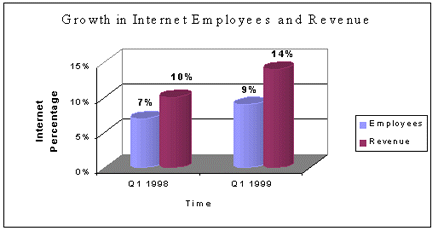

|
· The Internet Economy: Growth was strong in all layers of the economy, but E-commerce exploded, increasing 127 percent from Q1 1998 to Q1 1999. In Q1 1998, E-commerce accounted for 25.8 percent of Internet revenues. That figure jumped to 34.8 percent in Q1 1999 as companies leveraged investment in infrastructure to expand E-commerce.
University of Texas at Austin, © 1999 · E-Commerce is Fueling Major Growth in Internet-related Jobs The number of Internet-related jobs increased from 1.6 million in Q1 1998 to 2.3 million in Q1 1999 as new companies were created and others shifted employees to new assignments to take advantage of the opportunities of the Internet Economy. Nearly 400,000 E-commerce jobs alone were added in the last year, a 78 percent increase from Q1 1998. That tremendous growth dwarfed other layers. Infrastructure jobs increased by 184,000, or 39 percent. Application layer jobs increased 156,000, or 38 percent, and Intermediary job growth was 89,000, or 25 percent.
University of Texas at Austin, © 1999 · One in Three of the Internet Economy Companies Didn't Exist Before 1996 The Internet has unleashed a new entrepreneurial force in the United States that has led to remarkable company growth and job creation. For example, one in three of the 3,400 companies surveyed for this report did not even exist prior to 1996. These companies created in 1996 or later employ 305,000 employees - an excellent indicator of the Internet’s impact on job growth in the United States. In addition, 2,000 new secure Web sites are added each month, reflecting the number of businesses flocking to the Internet or expanding their online presence. · The Internet Economy Has a Major Impact on U.S. Economic Growth U.S. GDP is projected to grow $340 billion in 1999. The projected $200 billion growth in Internet Economy in 1999 plays a significant role in the health of the economy, although differences between GDP and revenues make a precise comparison difficult. While a significant portion of the initial growth in the Internet Economy could be attributed to a substitution effect whereby economic activities conducted in the physical or non-Internet world are now being transferred to the Internet, the projected $200 billion growth in 1999 clearly has a major impact on U.S. GDP. · The Internet is Adding to the Corporate Revenue Pie The portion of revenues derived from the Internet jumped from 10 percent in Q1 1998 to 14 percent in Q1 1999. In addition, the portion of jobs directly connected to the Internet jumped from 7 percent in Q1 1998 to 9 percent in the first quarter of 1999. Revenues increased faster than employees, suggesting productivity gains derived from the Internet. In fact, the analysis of revenue per employee in Internet-related companies found a 15 percent increase from Q1 1998 to Q1 1999.
· The Big Fish Don't Rule the Pond The Internet has proven to be strikingly similar to the rest of the economy in the relationship between corporate players and smaller “mom-and-pop” companies. The top ten companies in the study only account for 27 percent of all the Internet revenue. That indicates that just like the rest of the economy, major corporations are important but the bulk of the economic growth and job creation is driven by small businesses. In addition, smaller companies (outside the top 350) are more focused on sales to consumers this year than they were in Q1 1998. According to the data, 60 percent of sales were to consumers in the first quarter of 1999, compared to 45 percent last year. · Investors Value Internet-related Companies While the Wall Street mania over .com companies has reached epic proportions, research shows that investors strongly favor Internet-related companies and reward them with their investment dollars. The 294 companies doing the most business on the Internet have an average market capitalization of $18 billion. That is 30 times the $600 million average market cap for the 5068 total companies on NASDAQ. What this suggests is that companies not “connected” to the Internet are perceived by investors as behind the market curve and are not ready to leverage the New Economy. · The Internet Economy Now Exceeds Century-old Traditional Industries In the last year, the Internet Economy has zoomed past century-old industries such as telecommunications ($300 billion) and airlines ($355 billion) in size and is now approaching the publishing ($750 billion) and health-care industry ($1 trillion). For example, if the Internet Economy were to grow at just half its current rate (68 percent) for the next three years, it would generate $1.2 trillion in revenues in 2002. | |||||||||||||||||||||||||||||||||||||||||||||||||||||
 Source: Center for Research in Electronic Commerce, Graduate School of Business, University of Texas at Austin, © 1999
Source: Center for Research in Electronic Commerce, Graduate School of Business, University of Texas at Austin, © 1999